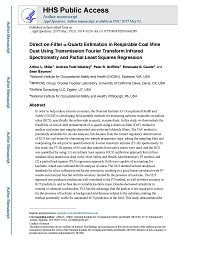Mining Publication: Direct-on-Filter alpha-Quartz Estimation in Respirable Coal Mine Dust using Transmission Fourier Transform Infrared Spectrometry and Partial Least Squares Regression
Original creation date: May 2017
Authors: AL Miller, AT Weakley, PR Griffiths, E Cauda, S Bayman
In order to help reduce silicosis in miners, the National Institute for Occupational Health and Safety (NIOSH) is developing field-portable methods for measuring airborne respirable crystalline silica (RCS), specifically the polymorph a-quartz, in mine dusts. In this study we demonstrate the feasibility of end-of-shift measurement of a-quartz using a direct-on-filter (DoF) method to analyze coal mine dust samples deposited onto polyvinyl chloride filters. The DoF method is potentially amenable for on-site analyses, but deviates from the current regulatory determination of RCS for coal mines by eliminating two sample preparation steps: ashing the sampling filter and redepositing the ash prior to quantification by Fourier transform infrared (FT-IR) spectrometry. In this study, the FT-IR spectra of 66 coal dust samples from active mines were used, and the RCS was quantified by using: (1) an ordinary least squares (OLS) calibration approach that utilizes standard silica material as done in the Mine Safety and Health Administration's P7 method; and (2) a partial least squares (PLS) regression approach. Both were capable of accounting for kaolinite, which can confound the IR analysis of silica. The OLS method utilized analytical standards for silica calibration and kaolin correction, resulting in a good linear correlation with P7 results and minimal bias but with the accuracy limited by the presence of kaolinite. The PLS approach also produced predictions well-correlated to the P7 method, as well as better accuracy in RCS prediction, and no bias due to variable kaolinite mass. Besides decreased sensitivity to mineral or substrate confounders, PLS has the advantage that the analyst is not required to correct for the presence of kaolinite or background interferences related to the substrate, making the method potentially viable for automated RCS prediction in the field. This study demonstrated the efficacy of FT-IR transmission spectrometry for silica determination in coal mine dusts, using both OLS and PLS analyses, when kaolinite was present.

- A Comparison of Respirable Crystalline Silica Concentration Measurements Using a Direct-on-filter Fourier Transform Infrared (FT-IR) Transmission Method vs. a Traditional Laboratory X-ray Diffraction Method
- Development of a Personal Real-Time Respirable Coal Dust and Respirable Silica Dust Monitoring Instrument Based on Photoacoustic Spectroscopy
- Direct-on-filter Analysis for Respirable Crystalline Silica Using a Portable FTIR Instrument
- Dust Considerations When Using Belt Entry Air to Ventilate Work Areas
- Evaluating the Use of a Field-based Silica Monitoring Approach with Dust from Copper Mines
- Laboratory Comparison of New High Flow Rate Respirable Size-Selective Sampler
- NIOSH Hazard ID 1 - Exposure to Silica Dust on Continuous Mining Operations Using Flooded-Bed Scrubbers
- A Novel Sampling Cassette for Field-based Analysis of Respirable Crystalline Silica
- Respirable Crystalline Silica Characteristics and Sources in U.S. Underground Coal Mines
- Respirable Size-Selective Sampler for End-of-Shift Quartz Measurement: Development and Performance